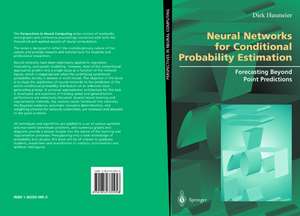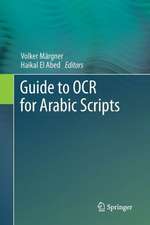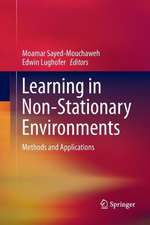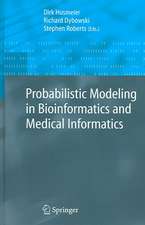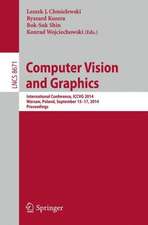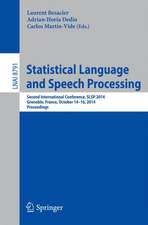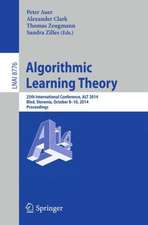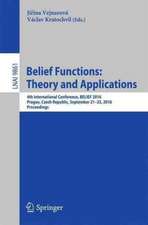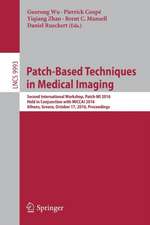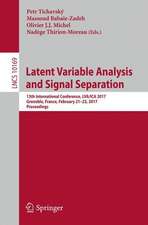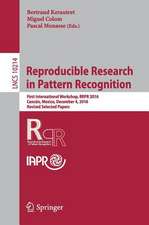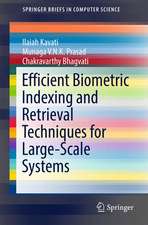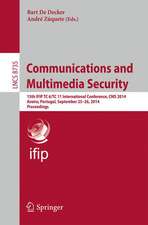Neural Networks for Conditional Probability Estimation: Forecasting Beyond Point Predictions: Perspectives in Neural Computing
Autor Dirk Husmeieren Limba Engleză Paperback – 22 feb 1999
Din seria Perspectives in Neural Computing
- 20%
 Preț: 986.66 lei
Preț: 986.66 lei - 20%
 Preț: 651.23 lei
Preț: 651.23 lei - 20%
 Preț: 1159.10 lei
Preț: 1159.10 lei - 20%
 Preț: 987.65 lei
Preț: 987.65 lei - 20%
 Preț: 648.44 lei
Preț: 648.44 lei - 20%
 Preț: 583.14 lei
Preț: 583.14 lei - 20%
 Preț: 989.79 lei
Preț: 989.79 lei - 20%
 Preț: 327.29 lei
Preț: 327.29 lei - 20%
 Preț: 339.34 lei
Preț: 339.34 lei - 20%
 Preț: 639.52 lei
Preț: 639.52 lei - 20%
 Preț: 648.59 lei
Preț: 648.59 lei - 20%
 Preț: 335.52 lei
Preț: 335.52 lei - 20%
 Preț: 646.80 lei
Preț: 646.80 lei - 20%
 Preț: 647.79 lei
Preț: 647.79 lei - 20%
 Preț: 641.49 lei
Preț: 641.49 lei - 15%
 Preț: 643.99 lei
Preț: 643.99 lei - 20%
 Preț: 329.91 lei
Preț: 329.91 lei - 20%
 Preț: 326.46 lei
Preț: 326.46 lei - 20%
 Preț: 643.50 lei
Preț: 643.50 lei - 20%
 Preț: 398.07 lei
Preț: 398.07 lei - 20%
 Preț: 646.47 lei
Preț: 646.47 lei - 18%
 Preț: 786.36 lei
Preț: 786.36 lei - 20%
 Preț: 326.64 lei
Preț: 326.64 lei - 20%
 Preț: 650.73 lei
Preț: 650.73 lei - 20%
 Preț: 648.26 lei
Preț: 648.26 lei - 20%
 Preț: 652.73 lei
Preț: 652.73 lei - 20%
 Preț: 648.76 lei
Preț: 648.76 lei - 20%
 Preț: 335.18 lei
Preț: 335.18 lei - 20%
 Preț: 335.88 lei
Preț: 335.88 lei
Preț: 334.20 lei
Preț vechi: 417.75 lei
-20% Nou
Puncte Express: 501
Preț estimativ în valută:
63.95€ • 68.38$ • 53.32£
63.95€ • 68.38$ • 53.32£
Carte tipărită la comandă
Livrare economică 18 aprilie-02 mai
Preluare comenzi: 021 569.72.76
Specificații
ISBN-13: 9781852330958
ISBN-10: 1852330953
Pagini: 300
Ilustrații: XXIII, 275 p. 13 illus.
Dimensiuni: 155 x 235 x 16 mm
Greutate: 0.47 kg
Ediția:Softcover reprint of the original 1st ed. 1999
Editura: SPRINGER LONDON
Colecția Springer
Seria Perspectives in Neural Computing
Locul publicării:London, United Kingdom
ISBN-10: 1852330953
Pagini: 300
Ilustrații: XXIII, 275 p. 13 illus.
Dimensiuni: 155 x 235 x 16 mm
Greutate: 0.47 kg
Ediția:Softcover reprint of the original 1st ed. 1999
Editura: SPRINGER LONDON
Colecția Springer
Seria Perspectives in Neural Computing
Locul publicării:London, United Kingdom
Public țintă
ResearchCuprins
1. Introduction.- 1.1 Conventional forecasting and Takens’ embedding theorem.- 1.2 Implications of observational noise.- 1.3 Implications of dynamic noise.- 1.4 Example.- 1.5 Conclusion.- 1.6 Objective of this book.- 2. A Universal Approximator Network for Predicting Conditional Probability Densities.- 2.1 Introduction.- 2.2 A single-hidden-layer network.- 2.3 An additional hidden layer.- 2.4 Regaining the conditional probability density.- 2.5 Moments of the conditional probability density.- 2.6 Interpretation of the network parameters.- 2.7 Gaussian mixture model.- 2.8 Derivative-of-sigmoid versus Gaussian mixture model.- 2.9 Comparison with other approaches.- 2.10 Summary.- 2.11 Appendix: The moment generating function for the DSM network.- 3. A Maximum Likelihood Training Scheme.- 3.1 The cost function.- 3.2 A gradient-descent training scheme.- 3.3 Summary.- 3.4 Appendix.- 4. Benchmark Problems.- 4.1 Logistic map with intrinsic noise.- 4.2 Stochastic combination of two stochastic dynamical systems.- 4.3 Brownian motion in a double-well potential.- 4.4 Summary.- 5. Demonstration of the Model Performance on the Benchmark Problems.- 5.1 Introduction.- 5.2 Logistic map with intrinsic noise.- 5.3 Stochastic coupling between two stochastic dynamical systems.- 5.4 Brownian motion in a double-well potential.- 5.5 Conclusions.- 5.6 Discussion.- 6. Random Vector Functional Link (RVFL) Networks.- 6.1 The RVFL theorem.- 6.2 Proof of the RVFL theorem.- 6.3 Comparison with the multilayer perceptron.- 6.4 A simple illustration.- 6.5 Summary.- 7. Improved Training Scheme Combining the Expectation Maximisation (EM) Algorithm with the RVFL Approach.- 7.1 Review of the Expectation Maximisation (EM) algorithm.- 7.2 Simulation: Application of the GM network trained with the EMalgorithm.- 7.3 Combining EM and RVFL.- 7.4 Preventing numerical instability.- 7.5 Regularisation.- 7.6 Summary.- 7.7 Appendix.- 8. Empirical Demonstration: Combining EM and RVFL.- 8.1 Method.- 8.2 Application of the GM-RVFL network to predicting the stochastic logistic-kappa map.- 8.3 Application of the GM-RVFL network to the double-well problem.- 8.4 Discussion.- 9. A simple Bayesian regularisation scheme.- 9.1 A Bayesian approach to regularisation.- 9.2 A simple example: repeated coin flips.- 9.3 A conjugate prior.- 9.4 EM algorithm with regularisation.- 9.5 The posterior mode.- 9.6 Discussion.- 10. The Bayesian Evidence Scheme for Regularisation.- 10.1 Introduction.- 10.2 A simple illustration of the evidence idea.- 10.3 Overview of the evidence scheme.- 10.4 Implementation of the evidence scheme.- 10.5 Discussion.- 11. The Bayesian Evidence Scheme for Model Selection.- 11.1 The evidence for the model.- 11.2 An uninformative prior.- 11.3 Comparison with MacKay’s work.- 11.4 Interpretation of the model evidence.- 11.5 Discussion.- 12. Demonstration of the Bayesian Evidence Scheme for Regularisation.- 12.1 Method and objective.- 12.2 Large Data Set.- 12.3 Small Data Set.- 12.4 Number of well-determined parameters and pruning.- 12.5 Summary and Conclusion.- 13. Network Committees and Weighting Schemes.- 13.1 Network committees for interpolation.- 13.2 Network committees for modelling conditional probability densities.- 13.3 Weighting Schemes for Predictors.- 14. Demonstration: Committees of Networks Trained with Different Regularisation Schemes.- 14.1 Method and objective.- 14.2 Single-model prediction.- 14.3 Committee prediction.- 14.4 Conclusions.- 15. Automatic Relevance Determination (ARD).- 15.1 Introduction.- 15.2 Two alternative ARD schemes.- 15.3Mathematical implementation.- 15.4 Empirical demonstration.- 16. A Real-World Application: The Boston Housing Data.- 6.1 A real-world regression problem: The Boston house-price data.- 16.2 Prediction with a single model.- 16.3 Test of the ARD scheme.- 16.4 Prediction with network committees.- 16.5 Discussion: How overfitting can be useful.- 16.6 Increasing diversity.- 16.7 Comparison with Neal’s results.- 16.8 Conclusions.- 17. Summary.- 18. Appendix: Derivation of the Hessian for the Bayesian Evidence Scheme.- 18.1 Introduction and notation.- 18.2 A decomposition of the Hessian using EM.- 18.3 Explicit calculation of the Hessian.- 18.4 Discussion.- References.
Caracteristici
Provides unique, comprehensive coverage of generalisation and regularisation: Provides the first real-world test results for recent theoretical findings on the generalisation performance of committees
